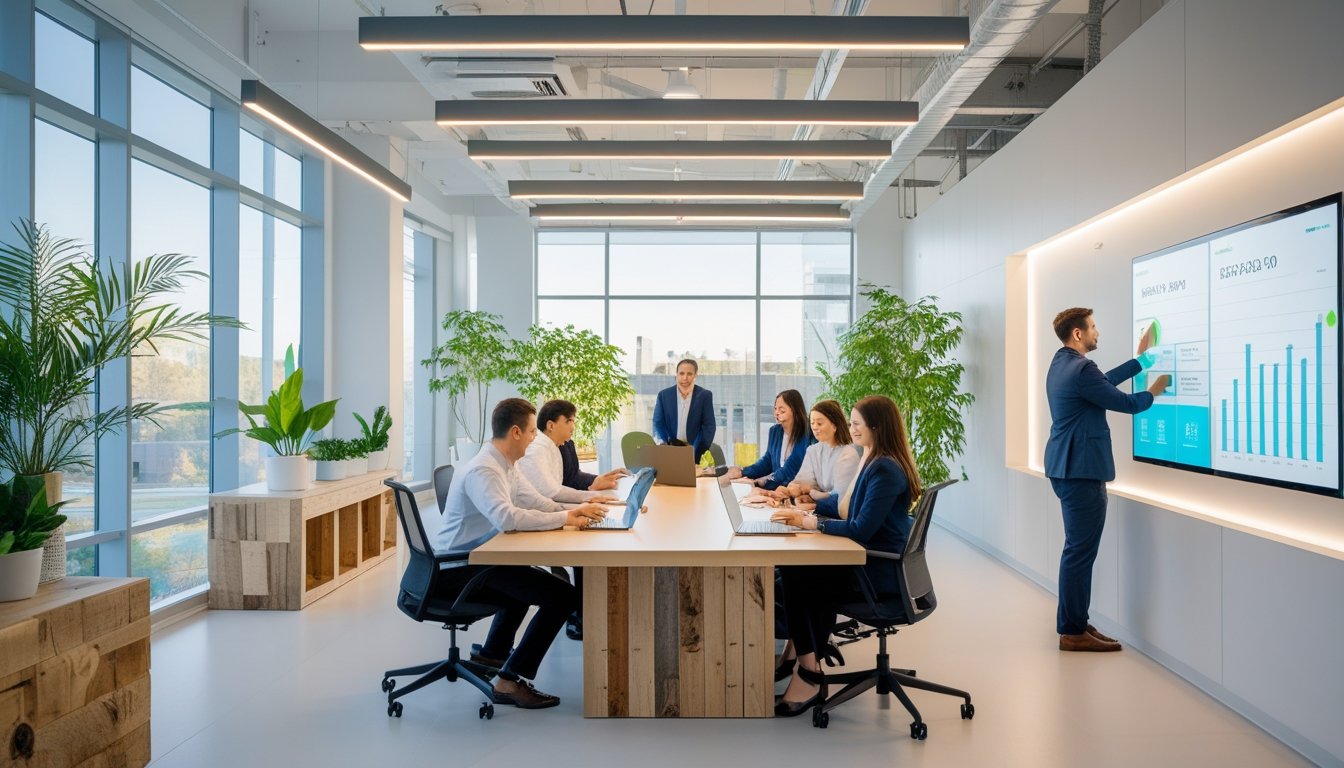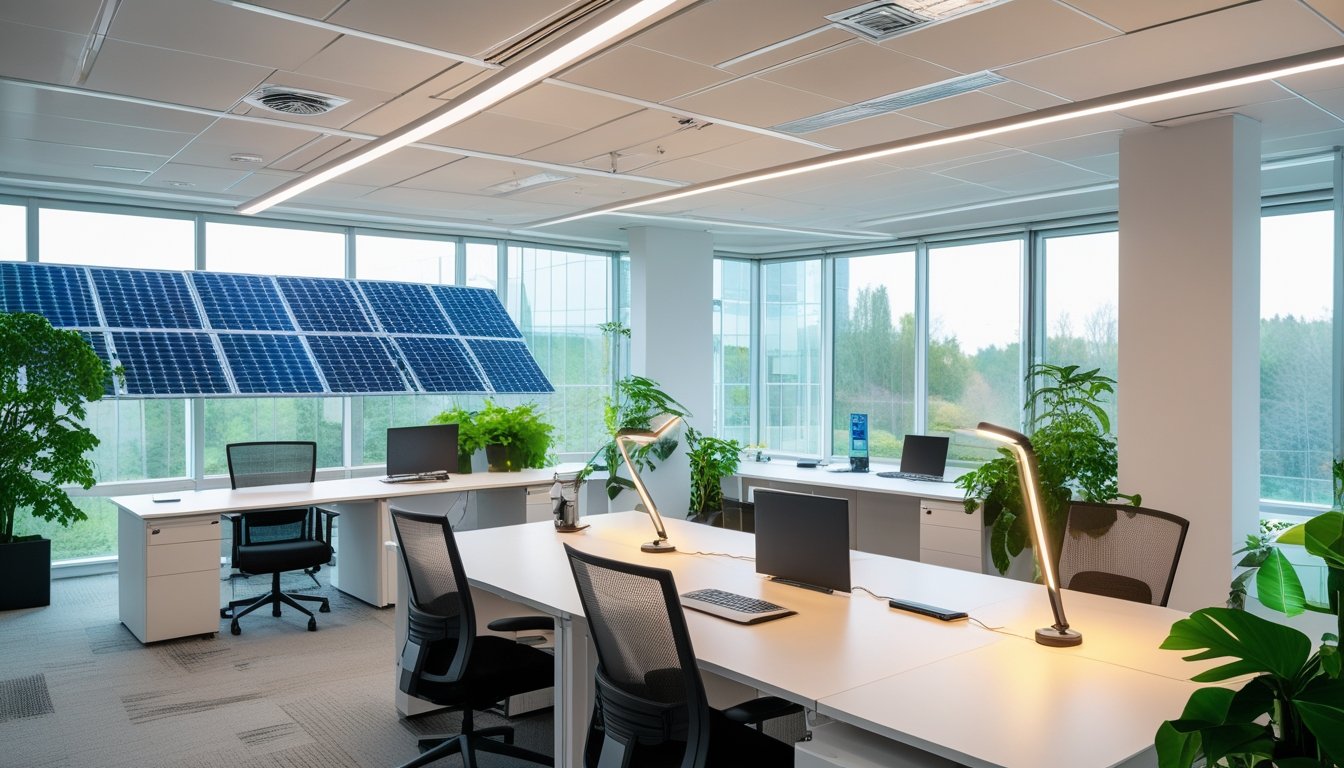Late updated: 26 May 2025 09:05
Written by: Amber Collins
Exploring Sustainable Office Lighting Options: Enhancing Workplace Efficiency
As we spend a significant portion of our day in offices, it is imperative to consider how our lighting choices impact both productivity and the environment. Sustainable office lighting options not only reduce energy consumption but also enhance the well-being of employees. LED lights and daylighting designs are excellent choices that offer energy efficiency and cost savings while minimising our carbon footprint.

Transitioning to eco-friendly lighting solutions can seem daunting, but the benefits are undeniable. Choosing energy-efficient bulbs and fixtures also means investing in a sustainable future. By integrating these elements, we can ensure a brighter and more sustainable working environment.
Exploring innovative solutions provides a myriad of benefits and paves the way for smarter energy use. Whether through smart lighting systems or utilising natural light, there are numerous ways to create an office space that is both efficient and environmentally conscious.
Key Takeaways
- Sustainable lighting options enhance energy efficiency.
- Eco-friendly choices support a healthier work environment.
- Innovative solutions contribute to environmental sustainability.
Fundamentals of Sustainable Office Lighting

In our exploration of sustainable office lighting, we delve into energy-efficient lighting choices that decrease carbon footprints and enhance employee well-being. The aspects discussed include the importance of lighting quality and the impact on productivity and creativity.
Core Principles of Energy-Efficient Lighting
Energy efficiency is paramount in sustainable lighting design. LED lighting stands out as an ideal choice due to its long life and reduced power consumption compared to traditional fluorescent lamps. LEDs utilise up to 75% less energy, significantly lowering utility bills.
Lighting control systems, such as dimmers and sensors, automatically adjust lighting based on occupancy and natural light availability, optimising energy use. Additionally, selecting office lighting with minimal toxic elements like mercury enhances its eco-friendliness. These strategies collectively play a critical role in reducing a building’s carbon footprint.
Understanding Illumination and Lighting Quality
Proper illumination in an office setting requires a balance of natural and artificial light to achieve optimal lighting quality. Task lighting helps in reducing glare and eye strain, promoting visual comfort. Desk lamps and under-cabinet LEDs are ideal for precision work, ensuring that every area receives necessary light without excessive brightness.
The Colour Rendering Index (CRI) measures how accurately a light source displays colours, impacting the overall atmosphere and mood. Lamps with a higher CRI (80–100) render colours more naturally, enhancing the workspace’s aesthetics and functionality. By prioritising lighting quality, we ensure both comfort and aesthetic appeal in office environments.
Impact of Lighting on Employee Well-Being
Lighting quality significantly affects employee well-being and productivity. Proper lighting design can elevate mood, boost energy, and reduce fatigue. This, in turn, enhances productivity and creativity. It is well-documented that natural light influences the circadian rhythm, leading to improved sleep quality and overall health.
By integrating daylight into office lighting strategies, we provide a healthier work environment. Furthermore, ensuring adjustable lighting options enables employees to personalise their workspaces, further enhancing satisfaction and efficiency. These considerations underscore the profound impact of sustainable lighting on employee morale and productivity.
Innovative Sustainable Lighting Solutions for Offices
Our commitment to sustainability and efficiency in office design warrants a closer inspection of modern lighting solutions. LED lighting and advanced technologies, smart controls, and natural lighting approaches are pivotal elements in achieving both energy efficiency and optimal workspace aesthetics.
LED Lighting and Advanced Technologies
LED Lighting is at the heart of sustainable office design. Light-emitting diodes (LEDs) boast a lengthy lifespan and remarkable energy-saving capabilities. Their high colour rendering index (CRI) ensures that colours appear vibrant and accurate in office settings, enhancing overall visual appeal.
With advancements in LED technology, contemporary solutions provide features like dimming capabilities and adjustable brightness. These functions allow for tailored lighting environments that can enhance both productivity and comfort. Implementing LED light bulbs can significantly decrease electricity costs over time.
Smart Controls and Adjustable Systems
Smart controls are transforming office lighting efficiency. By incorporating adjustable lamps and systems that react to occupancy and daylight levels, we can fine-tune the lighting to meet specific needs.
Notable examples include devices like the BenQ ScreenBar, which offers personalisation through automated brightness adjustments, supporting tasks without causing eye strain. Smart lighting solutions not only conserve energy by switching off lights in unused areas but also improve the overall working environment through customisation options.
Natural and Ambient Lighting Approaches
Natural light plays a vital role in sustainable office lighting by reducing dependence on electrical systems throughout the day. Strategic window placement and skylights maximise sunlight penetration.
Complementing natural light with ambient lighting can create a pleasant work atmosphere without harsh contrasts. Using accent lighting to highlight areas and maintain a balanced lighting solution is essential for reducing glare and improving employee wellbeing. This integration of natural and artificial sources supports a healthier workspace.
Selecting Suitable Lighting Fixtures
Choosing the right lighting fixtures for an office is crucial for both sustainability and practicality. Task lighting options, tailored to specific functions, can boost efficiency while maintaining an energy-friendly profile. A focus on versatile and durable materials will reduce replacement needs and waste.
Modern fixtures often incorporate LED light bulbs for enhanced functionality. Selecting fixtures with adjustable features like pivot arms or rotating shades can cater to various activities, offering flexibility in office lighting design. Striking the right balance in fixtures contributes to a well-lit, energy-efficient workspace.
Frequently Asked Questions

In exploring sustainable office lighting, we consider energy-efficient solutions such as LED lighting, practices to reduce energy usage, and methods for maximising natural light. Smart lighting systems offer added benefits, contributing to eco-friendly offices, while the choice of lighting significantly impacts employee wellbeing.
Which energy-efficient lighting solutions are recommended for office spaces?
LED lighting is a popular recommendation due to its efficiency and longevity. It's cost-effective, providing bright illumination with minimal energy consumption. Compact fluorescent lamps (CFLs) are another option, though not as efficient. Combining these with motion sensors or timers further reduces energy usage.
How can LED lighting contribute to a more sustainable office environment?
LED lights consume significantly less power than traditional bulbs. They emit less heat, reducing cooling needs. Their long lifespan means fewer replacements, minimising waste. This reduction in energy use and waste helps lower the overall carbon footprint of the office.
What practices can be adopted to reduce energy consumption in office lighting?
Turning off lights in unoccupied areas is simple yet effective. Utilising timers or motion sensors ensures lights are only on when needed. Encouraging employees to use task lighting rather than overhead lights can also reduce energy consumption significantly.
In what ways can natural light be maximised in office design to enhance sustainability?
Designing offices with large windows or skylights allows for more natural light. Positioning workstations near windows can maximise daylight utilisation. Utilising light-coloured walls and reflective surfaces helps distribute natural light throughout the space, reducing the need for artificial lighting during daylight hours.
What are the benefits of smart lighting systems in creating eco-friendly offices?
Smart lighting systems allow for customisation, adjusting light levels according to the time of day or occupancy. They can be controlled remotely and programmed for energy efficiency. These systems optimise lighting management, leading to reduced energy costs and a more sustainable office environment.
How does the choice of lighting impact employee wellbeing and productivity in the workplace?
Proper lighting can reduce eye strain and fatigue. Natural light boosts mood and energy, enhancing productivity. Poor lighting may lead to headaches or a lack of focus. By choosing the right lighting, we can create a comfortable, efficient workspace conducive to employee wellbeing and productivity.
